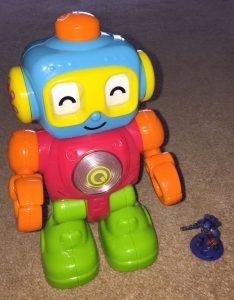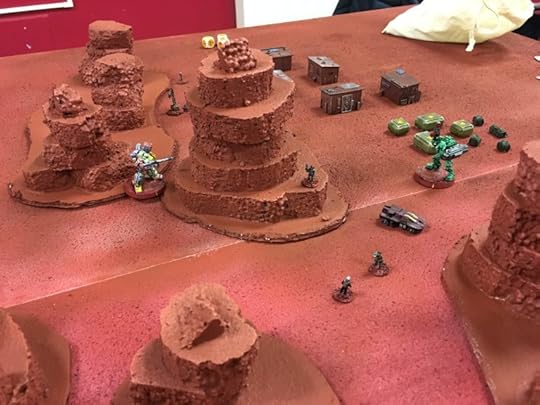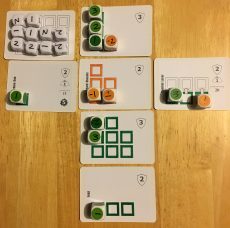Big Stompy Robots Are Marching On
 Welcome to the latest update on Big Stompy Robots. If this is the first you’ve heard of my new game, you can find out more about it here.
Welcome to the latest update on Big Stompy Robots. If this is the first you’ve heard of my new game, you can find out more about it here.
This blog is mostly about games design – specifically how to approach changing the game following play-testing. I’m using Big Stompy Robots as the example, and it gets a bit technical with the Big Stompy Robot rules, so if you haven’t already seen it, you may want to watch this video, which introduces the basic mechanics.
If you want to read even more about the game, there is a dedicated Big Stompy Robots newsletter – the next email will be going out in a few days.
With the ROBIN show out of the way, I didn’t do much for a few weeks. There was feedback from people that had played to percolate, and to be honest I wanted to spend a bit of hobby time on other things as this project had taken up all my attention for the preceding weeks.
The overwhelming sense I got from watching people play at ROBIN was that the system works, people enjoyed it, but there wasn’t enough of an ‘end game’ – a satisfyingly obvious conclusion to the battle. Part of this will be solved when I get around to creating the scenarios system, so that games don’t simply revolve around trying to get the other pilots to auto-eject. But more than that, there was something not quite working right with the way damage was accumulating and being repaired.
In such early stages of games design it’s sometimes hard to separate the rules from the gameplay to work out what is at fault. By this I mean that the rules might be working fine mechanically but the gameplay – the tactics we use, the pacing of the game – isn’t the right approach.
And that meant I had to think about what sort of game I was designing. Was this going to become a two-hours-for-a-game, or something more knockabout? What I want the final game to play like will affect the decisions I make throughout the rest of the project.
I’m all about fastplay, quick turnaround these days. My hobby and gaming time is limited, as is space, so those are my key factors. Nothing bigger than a 4’x4’ board required, and maybe half an hour tops to play, which means getting two or three games in an evening or just one game and some catching up with your friends!

With this in mind, I definitely needed the combat in Big Stompy Robots to be decisive rather than attritional, but the game I had wasn’t doing that. I couldn’t put my finger on it, so I arranged another game, this time against my friend Dave at the War and Peace Games Club, which I hope to frequent more in the future so keep an eye out if you are in the Nottingham area… Playing that game (and introducing Dave to the rules) highlighted what wasn’t working.
Table Time
It is easy to get drawn into writing the rules for a game without playing it enough. It’s a very rewarding intellectual exercise to wrinkle out the wording of a particular rule, or to start creating new weapons, scenarios and troop types. There’s nothing wrong with this, but in the earliest stages of a project what is vitally important is to maintain the connection between what you are writing and what happens when the models, cards or counters hit the tabletop.
Actually playing the game does two things. It highlights genuine problems with the system rather than theoretical ones. It also generates ideas, moments of ‘wouldn’t it be cool if…’ arising from actual gameplay.
One Thing At A Time
There are lots of moving parts to a game, especially a miniatures game. It’s a temptation to try to fix everything at once, but that removes any stable structure and changing too many things at the same time can obscure where the problems really lie.
So, for instance, because I was looking at how much damage the mechs could dish out and take, I had several avenues to explore. The most basic was the dice themselves. These aren’t regular D6, they are variously numbered depending on how ‘powerful’ I want them to be.
Cards & Dice Mocked up for ROBIN Event (thanks Kez!)
Power dice (green ones) are numbered 1, 1, 2, 2, 2, 3, while lower-powered white dice (no name for them yet…) are marked 1, 1, 1, 2, 2, 2. I could changes these values, make them higher, which would make shooting inflict more damage. But it would also change other parts of the game, such as movement, because they all use the same dice. I’m fairly happy with the values I’ve set, and at the moment don’t want to go back to something this fundamental (though you should always be prepared to go back to basics at any stage if it is needed).Similarly, the weapons themselves, and the armour values of the locations, are something I could look at. I might add extra dice to some of the weapons, or reduce the average armour values. In time there will be tweaking needed, but it’s an ever-shifting goal and balancing weapons against each other is something for a later development stage, I think, when everything else has settled down.
Learn To Play
One of the most important benefits of tabletop time is that you and your other players can learn the best way to play the game, which may not be immediately obvious. As an example, one of the areas I have been looking at is physical weapons versus energy weapons. Physical weapons have ammo that is expended during the game. I haven’t played or run a game yet in which a mech has had anything but a round or two of ammo left at the end. Conversely, energy weapons just need power, but usually more of it.
I was worried that either there was no point taking weapons with ammo limits, or that you would always want at least one energy weapon for the final stages of the game, which limits mech design quite a bit. However, playing Dave brought home to me the advantages of the physical weapons. As a game goes on and a mech accrues damage, you need to devote power to damage control. It becomes a much more constrained resource in later turns. This limits the amount of dice to fire weapons, move and power the piloting suite (which determines the number of activations you have).
In this situation, physical weapons are really useful because they tend to need only one or two dice of power to fire, but can add ammunition to make each shot more powerful. Basically, rather than firing off all the ammo at the first opportunity, the best use of these sorts of weapons is in the later stages, when energy weapons might require too much power to fire effectively.
So, not only did this thought process reassure me a little bit about the balance between the different weapon types, it also gave me a design parameter for future development: physical weapons should always be low power input, energy weapons should always require higher power input.

Game in progress at War & Peace Games Club
Simple But Significant Changes
As I mentioned earlier a game is complex and even small changes (like the values on a dice) can have wide-ranging consequences. I’m trying to alter as few things as possible at any given moment so that I can keep a clear line between cause-and-effect, watching how each of the mechanics interacts to create the gameplay. Little tinkering can give big results if you move the right piece, and if you move too many it’s impossible to track what is working and what isn’t.
In the end I have chosen a very simple solution, which both gives the game a better flow, I think, but also reduces the opportunities for pilots to perform damage control. Originally I had a turn sequence that allowed the players a free ‘reactor activation’ at the start of each turn, distributing dice to the other systems, performing damage control, etc. I have removed that free phase, which means less time for damage control and also has some pleasing implications for how the card activation system works (which I’ll be looking at in a video in a few weeks’ time).
That’s all I have to do at the moment.
I will play the game again with that simple alteration and see what effect it has. If more changes are needed then I’ll look at something else, but I am reasonably confident at this stage that it should do the job.
If you want to keep up with the game’s development, please sign up to my dedicated Big Stompy Robots newsletter. You can also read my developer diary over on the Big Stompy Robots page. And if you want to have a demo game, I’ll be taking it to the new wargames show ChillCon in Sheffield on the 27th May.
Please Feel Free to Share:











